How effective are push notifications: In-app messaging vs SMS
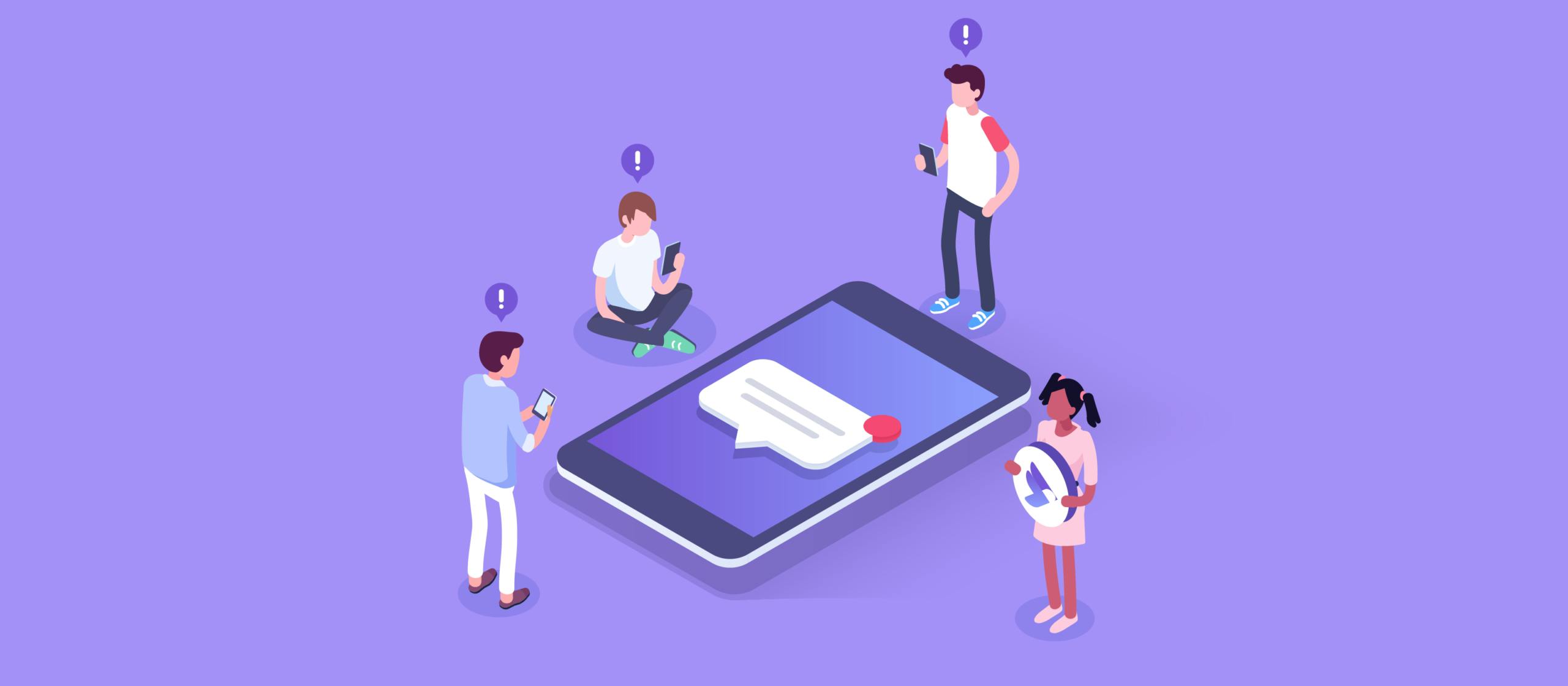
Push notifications have the power to bring users back into your app by alerting them of an article they’d like, a relevant discount, a message from a fellow app user, and much, much more.
As a business communication tool, these in-app notifications help bring your brand directly to your customers – providing value every time.
Push notifications powered by an in-app chat and messaging platform are often compared to SMS. However, SMS are sent as text messages – meaning that the only way they lead back to your app is through a link.
In-app notifications are a better version of SMS because they are a branded experience without the hidden costs of SMS marketing. And despite SMS’s strong open rates, it isn’t the future of in-app, messaging-based business communication.
This article covers:
- SMS notifications and their drawbacks:
- SMS is sent from an anonymous phone number
- SMS is a one-way message
- SMS notifications force users to leave your apps
- In-app notifications and push notifications
- Can help you engage your mobile and web app users
- Can send rich multimedia messages, whether video, audio, images, or structured or templated messages, coupons, etc.
- Allows you to brand your user’s messaging experience
- Provides rich data, allowing you to track logistics or other critical info
What are push notifications, and how do they work?
A push notification is a message that pops up on a mobile device.
In-app chat vs SMS: Which option is right for your app?
Text notifications using SMS
A text notification is a message sent to a mobile phone and can be used by businesses and applications to reach mobile phone users. Twilio popularized SMS and MMS for marketing notifications by creating an API for developers to integrate various SMS functionalities into their software or apps.
You can imagine the appeal of text notifications. As long as you know a user's phone number and have their permission, you can essentially reach them at any time.
And yet, over time, SMS is proving useful in only a narrow set of use cases, like two-factor authentication and reaching users outside your application.

How does your mobile engagement score stack up?
Problems with SMS text notifications
Problem 1: SMS is sent from an anonymous phone number
First, the text notification is sent to the mobile phone from an anonymous phone number, creating two related problems:
Problem 1.1: SMS looks like spam
More and more, SMS marketing appears to be spam or phishing because the user doesn’t recognize the number from which it is sent – like the phone calls from your area code that turn out to be a spam phone call. This decreases a customer’s trust in your brand, and eliminates an opportunity to make communication an owned, branded experience.
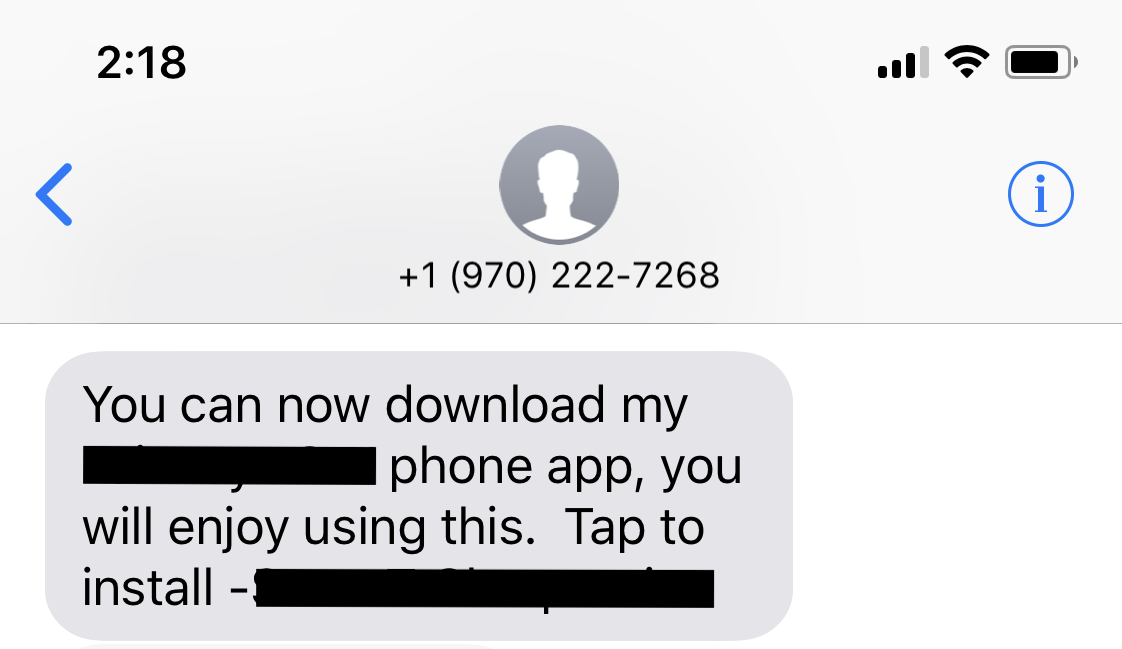
Problem 1.2: SMS data isn’t owned
Since SMS is anonymous and sent through complicated mobile carriers, it is extremely difficult to track and cannot be attached to a unique customer ID. This means that personalized, valuable content is difficult to get to your customer.
Read more about the intricacies of SMS costs.
In addition weighing SMS’s costs with its opportunities, it creates difficult logistics. Who is communicating with whom? When and why are they behaving as they do? What segment of our audience is this?
Problem 2: SMS is a one-way message
Despite having a 29% reply-rate, SMS is essentially a one-way message because your ability to respond is limited and clunky.
How else can you follow up except by a bot and what happens on the next interaction? And where is the response stored and how do you follow up?
Since SMS is almost entirely a one-way message, it cannot coordinate between multiple parties or support complex interactions.
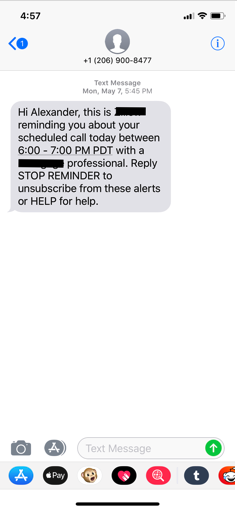
Problem 3: SMS forces users to leave your app
With SMS, the user must leave the app to check the message. In some cases, like delivery, this can be helpful as you can use both SMS and in-app notifications to alert your customer of a delivery.
However, SMS doesn’t provide tracking or direct messaging between the restaurant, the driver, and your customer.
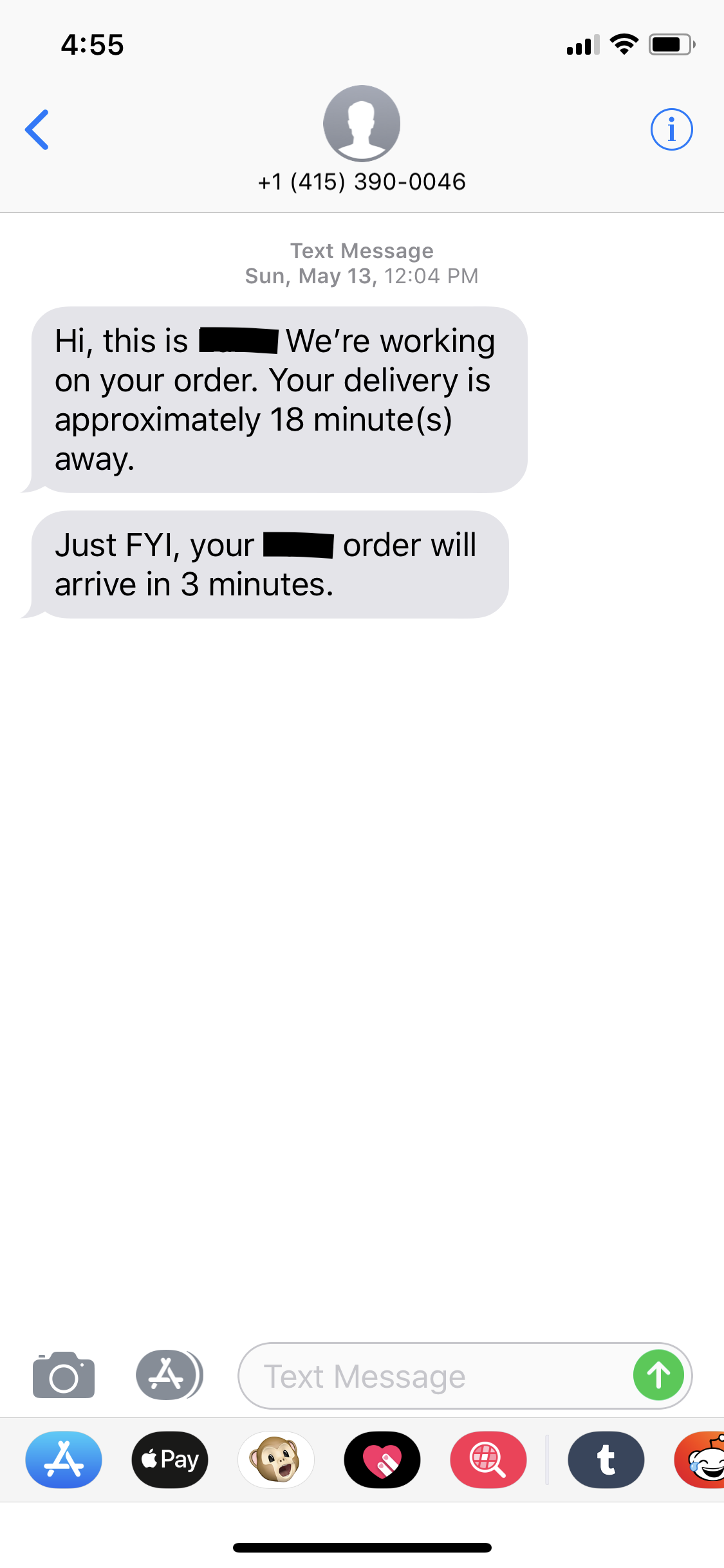
Benefits of text notifications via SMS vs in app notifications and push notifications
If SMS read rates are north of 90%, then your user leaves your app over 90% of the time it receives an SMS while in your application. SMS decreases the time users spend on your applications.
Text notification is still necessary for two-factor authentication through the phone, user invitations to phone contacts, one-way marketing blasts, etc.
But it might be time for app-makers and marketers to stop making due with older technology and start building out a notification and messaging experience that engages users.
In-app messaging and mobile push notifications
In app messaging is a way to send messages and support user chat and messaging within the ecosystem of your application using Internet Protocol (IP). It is also called IP messaging or native messaging, but each name has slightly different connotations. Since in app messaging uses IP, it requires an internet connection either through WiFi or a mobile internet connection. It also requires a user to download and use your app.
There can be many message types. The messages can be 1-to-1:
- Business to user
- User to user
- Service provider to user
- Buyer to seller
- Customer to support
- Admin to user
The messages can also occur in private group chats between 3 or 300 or more users, or in large-scale public channels in the tens or even hundreds of thousands of users.
In app messaging also supports push notifications for users that opt-in. And it can send any multimedia of much larger data sizes, but the speed will vary by the mobile phone’s internet connection.
Push notifications using IP messaging
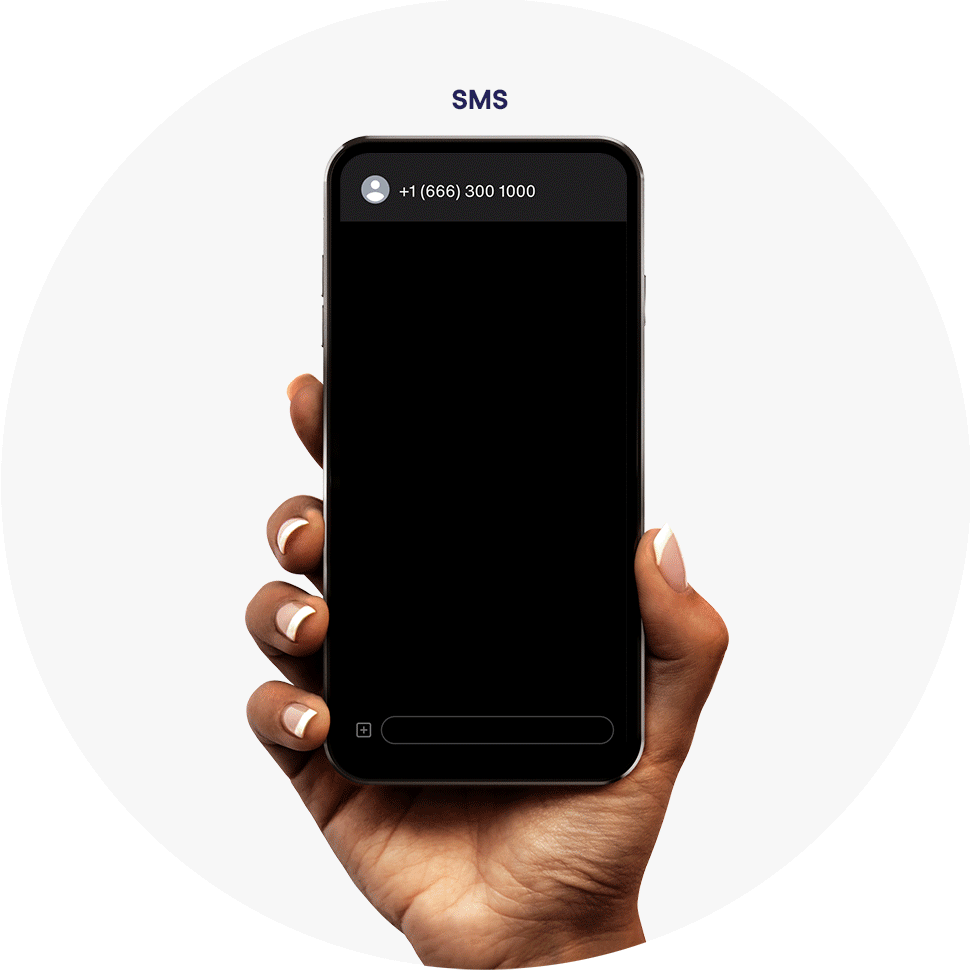
Push notifications are the SMS of IP messaging, except they can include rich features like images, video, sound, calls-to-action or templated messages. They send messages directly to your user’s home screen.
As you can see from the above definition, comparing in-app messaging to SMS text notifications is like comparing apples to oranges. SMS is only a text notification and uses a phone number, whereas in-app messaging and notifications include many types of messaging and functionality, of which push notifications are only a small part.
To narrow our comparison, let’s only consider push notifications in app messaging.
If text notification using SMS, e-mail, or social media is a good tool for acquiring users, then push notifications using in-app messaging is a great tool for reaching the people already using your application – to engage and retain them, to increase their Lifetime Value for your application and business. Our guide to mobile push notifications has everything you need to know about their benefits, and how they can be used.
15 mobile push notification examples to inspire you.
Sendbird Notifications
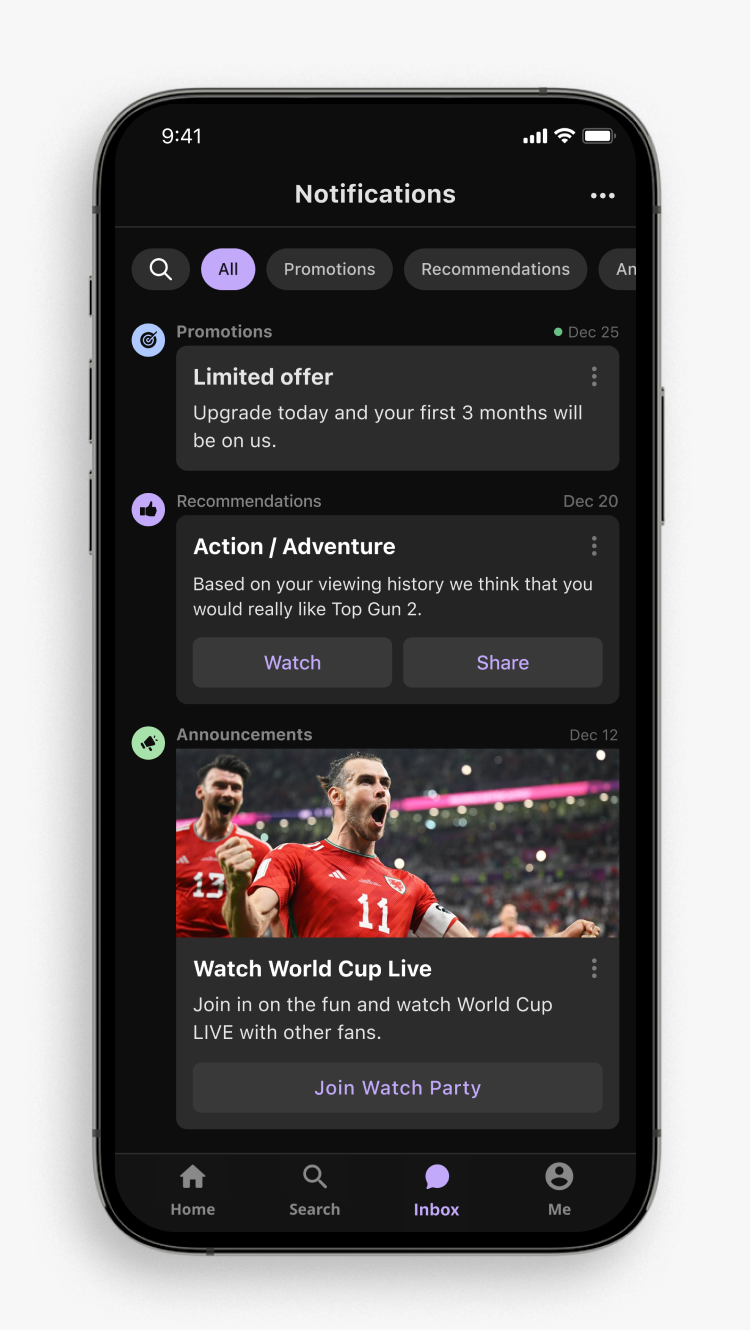
All your push notifications, in-app notifications, and messages can also be organized within your app in a dedicated notification center. That way, your customer isn’t confused about multiple notifications – especially if your app has a social element in addition to promotions and support.
All of your branded message app alerts, in one place.
In-app messaging best practices & benefits
This is the value of in-app messaging’s namesake. In app messaging keeps your user in your application. It retains them longer.
“In app messages drive 3.5X higher user retention.”
- Push notifications combined with in-app messaging are a potent retention method because you can use in-app messages from friends or other users to draw app-users back into your application.
- You can send notifications to highlight specific content by sending video or audio
- You can send targeted offers, coupons, or shopping suggestions
- You can send real-time updates about live events
If your in-app messaging notifications send updates about any app related event (i.e. a delivery, ride-hailing, or any other service), these notifications already offer an extremely high value to your user.
In app messaging allows you to send multimedia, structured or templated messages, and more
With in app messaging you can send structured or templated messages – messages that include photos, calls to action, other buttons, or other multimedia elements – to your users as a notification or simply in a message or group chat.
This works well for sales, coupons, or nudging your customer, especially when personalized according to their buying or messaging patterns.
In one case, TMON achieved 21% sales conversion through live-commerce – a combination of live video and live chat.
Your brand, your in-app notification
The best in-app messaging APIs will allow your business to customize your messaging UI to your brand. This is not the case with the Facebook Messenger API or, for gaming, the Discord API. In both cases, the in app messaging each provides is branded with Facebook and Discord. This is great for Facebook and Discord but not for your business.
With branded app alerts, your user knows they’re receiving a message from your application and your business. And since they’ve downloaded your app and you provide a service they love, they will never consider it anonymous spam.
In-app push notifications are data rich
Continuous logging allows messaging apps to understand why your users talk when they talk, and when they consider a conversion complete.
With owned data, you can understand how your users chat and personalize the messaging experience to meet their needs better. For logistics, it can help you ensure complete communication between two parties because you may be able to notice, for example, when a Lyft, Uber, Grab, or GO-JEK driver has not responded to a customer’s message and sent them a push notification reminding them to complete the communication.
Push notifications vs text notifications
In app messages from friends and your business combined with well-targeted push notifications are a great strategy to engage, retain, convert, and excite your app users. Sendbird’s complete chat solution can bring both to your application and build out your chat and messaging features, customized to your industry and application’s use case.










